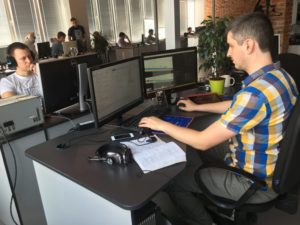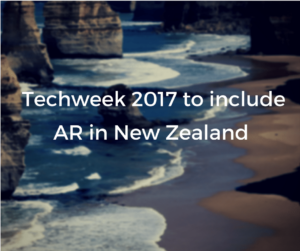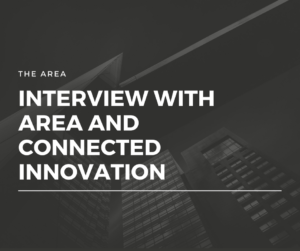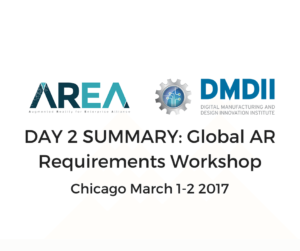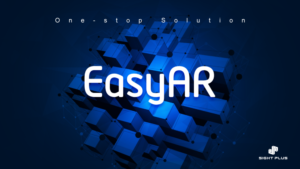Katie Mulligan of UI Labs has posted a blog entry that offers the organization’s perspective on the recent Global AR Requirements Workshop convened by DMDII and the AREA: –
Sometimes in the Wild West of rapidly evolving technology, we’re stronger working together than alone. A recent workshop proved that’s the mindset of Lockheed Martin, Caterpillar, and Procter and Gamble, which teamed up to lead a discussion of augmented reality (AR) functional requirements in hopes of moving this new technology forward and training the workforce of the future.
AR has essential applications for today’s manufacturing landscape, filling the gaps in expertise emerging as an older generation retires.
“Young people aren’t going to school to be mechanics,” said Lonny Johnson, an AR subject matter expert formerly with Caterpillar who helped facilitate the workshop. “We need to give them tools to help them learn quicker and easier.”
Unlike its cousin, virtual reality, AR is used when a machine or tool is present—to project work instructions onto an assembly line or to highlight steps to fix a machine under repair, for example. The technology’s uses run the gamut, but AR providers have struggled to understand the needs of industry, slowing wide-scale adoption by manufacturers.
To help form a consensus about the necessary functional requirements for AR, Lockheed, Caterpillar, and P&G hosted the Augmented Reality Workshop on March 1-2 in conjunction with UI LABS and the Augmented Realty for Enterprise Alliance (AREA), a global membership organization focused on reducing barriers and accelerating adoption of AR technologies.
“The AR Workshop was a truly groundbreaking event as it was the first time that enterprises, AR providers, and non-commercial organizations worked together and drafted a set of global AR requirements,” said Mark Sage, Executive Director of AREA. “These requirements will be used to help develop the AR ecosystem, and AREA is looking forward to communicating and driving future changes.”
The three corporate leaders worked collaboratively in advance to develop functional requirements; they then solicited feedback from DMDII members and other attendees during the workshop, held at the UI LABS Innovation Center on Chicago’s Goose Island. The effort originated as a Partner Innovation Project, or PIP, in which DMDII partners come together to engage in R&D outside of the traditional project call process and fund their project without government dollars.
Representatives from the three industry hosts led the discussion, addressing aspects across both software and hardware, including wearable technology, Skype, voice controls, and remote support. The moderators took feedback from an audience of nearly 100 participants from more than 50 organizations—including industry, AR providers, universities, and government agencies—who shared their needs and hopes for the future of AR, and described challenges they face using the technology today.
The output of the discussion—which will form the basis for a forthcoming report—will help educate enterprises and AR providers, serve as a tool to aid product planning, and give AR service providers insight into what enterprises want.
As with any new technology, one of the greatest challenges surrounding augmented reality is persuading users—in this case, manufacturers—to adopt it. If an individual has a bad experience, “it will die on the vine,” said Johnson. But as people discover its usefulness and it begins to infiltrate the workplace, we’ll likely see wider adoption.
“One success builds on another success, which builds on another. It’s all about culture,” he added.
Ensuring the technology is ready for widespread use requires cooperation. Lockheed, Caterpillar, P&G, and the other organizations at the workshop recognize the value of face-to-face collaboration, and the importance of working through these issues together in the name of innovation.
